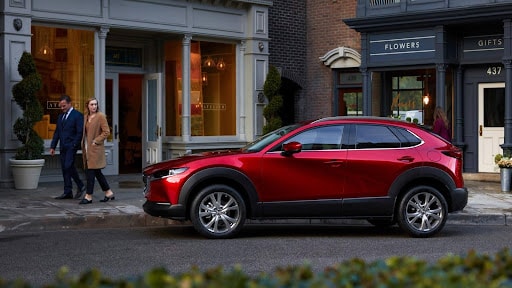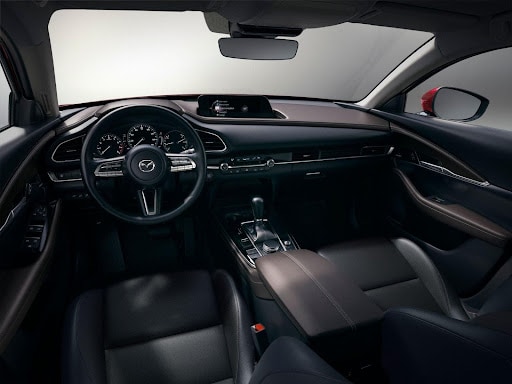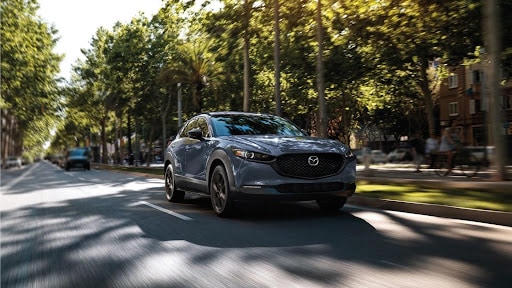
When it comes to compact crossovers that blend urban agility with style and substance, few match the energy of the Mazda CX-30 and Hyundai Kona. Both offer bold design, premium interiors, and tech-forward features, yet they express personality in very different ways. At Wellesley Mazda, part of the Shaker Auto Group, we often hear from New England drivers asking which of these small SUVs offers more character, capability, and everyday practicality. Let’s break down where each model shines and how the CX-30 distinguishes itself for drivers in Wellesley, MA and beyond.
What makes the Mazda CX-30 stand out in everyday driving?
The CX-30 is built around Mazda’s driver-first philosophy. Under the hood, it offers a standard 2.5-liter four-cylinder engine producing 191 horsepower, paired with a responsive six-speed automatic transmission. For those who crave more excitement, the available turbocharged version delivers up to 250 horsepower with premium fuel, class-leading numbers in this segment.
Mazda’s predictive i-Activ all-wheel-drive system comes standard across all trims, giving the CX-30 an edge on New England’s winding roads and unpredictable weather. Whether navigating Route 9 or handling icy conditions in the Berkshires, this SUV provides confidence and poise. The suspension tuning is another highlight, it’s tuned for balance and precision, translating to a ride that feels more European than economy.
Inside, the CX-30 feels more like a luxury compact than a mainstream SUV. Soft-touch materials, minimalist design, and available leather seating surfaces create an upscale atmosphere. The center console and intuitive control layout reflect Mazda’s philosophy of Jinba Ittai, driver and machine as one. For commuters in Wellesley or students driving to Boston, that tactile, connected feel is something the Kona simply can’t replicate.
How does the Hyundai Kona compare on performance and comfort?
The Hyundai Kona makes a solid case with its wide range of trims and efficient powertrains. The base model’s 147-horsepower engine is tuned for economy rather than engagement, while the available 190-horsepower turbo engine brings stronger acceleration. The new Kona Electric variant also appeals to eco-conscious drivers seeking zero-emission driving around the Boston suburbs.
However, the Kona’s handling is more comfort-oriented than dynamic. Its steering feels lighter, and the ride prioritizes cushioning over precision. For drivers who want a relaxed commute and straightforward performance, the Kona delivers. Yet for those who see driving as more than transportation, the CX-30’s chassis tuning and throttle response deliver a more emotional connection.

What are the key differences in interior design and technology?
Both the CX-30 and Kona offer modern cabins, but their approaches diverge. Mazda emphasizes simplicity and tactile quality; Hyundai leans into bold design and gadgetry.
The CX-30 features an 8.8-inch infotainment display controlled by a center dial rather than touch inputs. This keeps the driver’s eyes forward, a subtle but deliberate ergonomic advantage. Wireless Apple CarPlay, Android Auto, and an available 12-speaker Bose sound system make long drives rewarding. The clean, horizontal layout creates a calming, driver-centric environment.
The Kona, on the other hand, includes a larger touchscreen interface (up to 12.3 inches in newer models), offering a more visual tech experience. Its cabin materials, while functional, can’t quite match the CX-30’s refinement. For drivers who value tactile feel and quiet sophistication, Mazda holds the advantage. For those who prefer a digital-forward setup with vivid displays, Hyundai may feel more engaging.
How do these SUVs handle space and practicality for New England living?
Space efficiency matters when your weekend plans range from Cape Cod beach trips to ski runs in Vermont. The Mazda CX-30 offers 20.2 cubic feet of cargo space behind the rear seats and up to 45.2 cubic feet with them folded, enough for groceries, luggage, or sports gear. The rear seats are slightly cozier, ideal for occasional adult passengers or kids.
The Kona provides a bit more rear passenger space and slightly higher cargo volume (up to 45.8 cubic feet). Its shape and upright profile lend a roomier feel. However, Mazda’s sound insulation and material quality create a more serene environment during long highway drives, a valuable trait during New England winters when road noise tends to amplify.
Which SUV offers better safety and driver-assistance features?
Both vehicles prioritize safety with advanced driver-assistance systems. The Mazda CX-30 comes standard with Mazda’s i-Activsense suite, including adaptive cruise control, lane departure warning, lane departure warning, and driver attention alert. Available features such as a 360° view monitor and traffic jam assist elevate its safety technology beyond what’s typical in the class.
The Hyundai Kona counters with its SmartSense package, which also includes lane-keeping assist, blind-spot monitoring, and forward-collision avoidance. Both models earned strong ratings from the IIHS, with the CX-30 often receiving the Top Safety Pick+ designation thanks to its advanced crash performance and standard LED headlights.
For families or commuters driving year-round through Wellesley’s seasonal weather, that consistency in visibility and traction makes the CX-30 an especially compelling choice.

Why might New England drivers prefer the Mazda CX-30?
The CX-30’s appeal in Wellesley and across New England lies in its balance of sophistication, performance, and all-weather capability. We understand our customers value vehicles that perform as beautifully on a scenic fall drive through the White Mountains as they do on a snowy weekday commute. The CX-30’s combination of turbocharged strength, refined interior design, and standard AWD makes it uniquely suited to the region’s lifestyle.
As part of the Shaker Auto Group, we’ve seen drivers trade in various small SUVs, from Subarus to Volkswagens, in favor of the CX-30’s distinct blend of handling precision and upscale comfort. While the Hyundai Kona stands out for value and tech, it can’t match Mazda’s cohesive design philosophy, where every detail, from the steering feedback to the seat stitching, contributes to a unified driving experience.
Who wins the style and personality battle?
Design is subjective, but swagger isn’t just about looks, it’s about presence. The Mazda CX-30’s sculpted lines and flowing Kodo design language give it a poised, athletic stance. It looks premium without trying too hard. The Kona is expressive, with a sportier and sometimes quirkier aesthetic, especially in its N Line trims. Younger buyers may gravitate toward its boldness, while others appreciate Mazda’s understated sophistication.
For many Wellesley drivers, the CX-30’s refinement makes it feel like a smaller sibling to luxury crossovers, offering class-above aesthetics without the luxury price tag. It’s confident, elegant, and unmistakably Mazda.
Final thoughts: which SUV truly delivers more swagger per square inch?
Both the Mazda CX-30 and Hyundai Kona bring impressive strengths to the compact SUV market. The Kona appeals with versatility, tech options, and electric availability. The CX-30, meanwhile, delivers a driving experience that feels genuinely premium, balanced, responsive, and refined.
For New Englanders who value all-weather traction, elegant design, and the emotional connection of driving, the Mazda CX-30 stands out as the crossover with more swagger per square inch. At Wellesley Mazda, we see it every day in the way customers respond to its blend of style and substance, it’s not just transportation, it’s an experience.
For more information, CX-30 inventory, and test drives, visit us today.
*Penned by AI, polished by humans